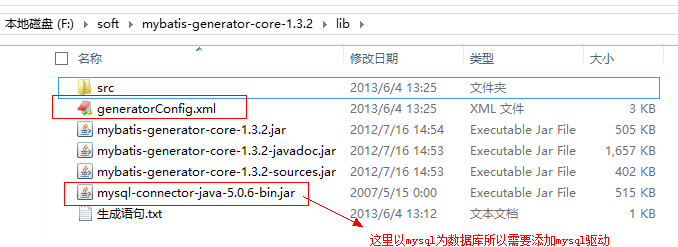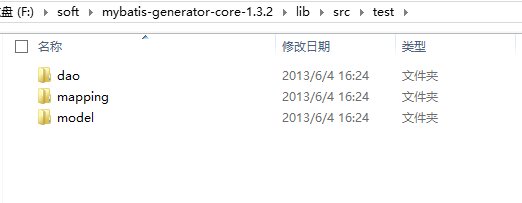MyBatis学习4---使用MyBatis_Generator生成DtoDaoMapping
Posted borter
tags:
篇首语:本文由小常识网(cha138.com)小编为大家整理,主要介绍了MyBatis学习4---使用MyBatis_Generator生成DtoDaoMapping相关的知识,希望对你有一定的参考价值。
由于MyBatis属于一种半自动的ORM框架,所以主要的工作将是书写Mapping映射文件,但是由于手写映射文件很容易出错,所以查资料发现有现成的工具可以自动生成底层模型类、Dao接口类甚至Mapping映射文件。
一、建立表结构
CREATE TABLE `user` (
`id` varchar(50) NOT NULL,
`username` varchar(18) CHARACTER SET utf8 COLLATE utf8_bin DEFAULT NULL,
`password` varchar(18) DEFAULT NULL,
`email` varchar(50) DEFAULT NULL,
`name` varchar(18) DEFAULT NULL,
`sex` varchar(2) DEFAULT NULL,
`birthday` varchar(50) DEFAULT NULL,
`address` varchar(500) DEFAULT NULL,
`tel` varchar(18) DEFAULT NULL,
`qq` varchar(18) DEFAULT NULL,
`image` varchar(50) DEFAULT NULL,
`sfjh` varchar(1) DEFAULT NULL,
`sfzx` varchar(1) DEFAULT NULL,
`sfhf` varchar(1) DEFAULT NULL,
`sfpl` varchar(1) DEFAULT NULL,
`sffx` varchar(1) DEFAULT NULL,
PRIMARY KEY (`id`)
) ENGINE=InnoDB DEFAULT CHARSET=utf-8;
二、下载mybatis-generator-core
进入:http://code.google.com/p/mybatis/
选择Downloads,再选择MyBatis Generator Tool下载即可。
三、生成配置文件
新建一个空的XML配置文件,名称可以随便取,这里以generatorConfig.xml为名。最好将这个文件放在下载后的lib目录中,如图:
其中mysql的驱动可以随便放在非中文路径的地方,这里为了方便就放在lib目录下。
自动生成最重要的就是配置文件的书写,现在就开始介绍generatorConfig.xml这个文件的具体内容:
-
-
-
-
-
<generatorConfiguration>
-
<!-- 数据库驱动-->
-
<classPathEntry location="mysql-connector-java-5.0.6-bin.jar"/>
-
<context id="DB2Tables" targetRuntime="MyBatis3">
-
<commentGenerator>
-
<property name="suppressDate" value="true"/>
-
<!-- 是否去除自动生成的注释 true:是 : false:否 -->
-
<property name="suppressAllComments" value="true"/>
-
</commentGenerator>
-
<!--数据库链接URL,用户名、密码 -->
-
<jdbcConnection driverClass="com.mysql.jdbc.Driver" connectionURL="jdbc:mysql://localhost/test" userId="test" password="test">
-
</jdbcConnection>
-
<javaTypeResolver>
-
<property name="forceBigDecimals" value="false"/>
-
</javaTypeResolver>
-
<!-- 生成模型的包名和位置-->
-
<javaModelGenerator targetPackage="test.model" targetProject="src">
-
<property name="enableSubPackages" value="true"/>
-
<property name="trimStrings" value="true"/>
-
</javaModelGenerator>
-
<!-- 生成映射文件的包名和位置-->
-
<sqlMapGenerator targetPackage="test.mapping" targetProject="src">
-
<property name="enableSubPackages" value="true"/>
-
</sqlMapGenerator>
-
<!-- 生成DAO的包名和位置-->
-
<javaClientGenerator type="XMLMAPPER" targetPackage="test.dao" targetProject="src">
-
<property name="enableSubPackages" value="true"/>
-
</javaClientGenerator>
-
<!-- 要生成哪些表-->
-
<table tableName="about" domainObjectName="AboutDto" enableCountByExample="false" enableUpdateByExample="false" enableDeleteByExample="false" enableSelectByExample="false" selectByExampleQueryId="false"></table>
-
<table tableName="user" domainObjectName="UserDto" enableCountByExample="false" enableUpdateByExample="false" enableDeleteByExample="false" enableSelectByExample="false" selectByExampleQueryId="false"></table>
-
<table tableName="syslogs" domainObjectName="SyslogsDto" enableCountByExample="false" enableUpdateByExample="false" enableDeleteByExample="false" enableSelectByExample="false" selectByExampleQueryId="false"></table>
-
</context>
-
</generatorConfiguration>
1、其中需要注意的有数据库驱动、数据库URL、用户名、密码、生成模型的包名和位置、生成映射文件的包名和位置、生成DAO的包名和位置以及最后需要生成的表名和对应的类名。
四、运行
需要通过CMD命令行方式来运行,首先可以先准备一个运行的脚本,这里使用的脚本是:java -jar mybatis-generator-core-1.3.2.jar -configfile generatorConfig.xml -overwrite
需要注意的是:mybatis-generator-core-1.3.2.jar为下载的对应版本的jar,generatorConfig.xml 为配置文件名,如果不为这个可以在这里进行修改。
启动cmd进入到“F:softmybatis-generator-core-1.3.2lib”这个目录下,如图:
生成成功后进到src目录下,可以看到已经生成了对应的model、dao、mapping,如图:
下面可以看看生成后的UserMapper.xml
-
-
-
<mapper namespace="test.dao.UserDtoMapper" >
-
<resultMap id="BaseResultMap" type="test.model.UserDto" >
-
<id column="id" property="id" jdbcType="VARCHAR" />
-
<result column="username" property="username" jdbcType="VARCHAR" />
-
<result column="password" property="password" jdbcType="VARCHAR" />
-
<result column="email" property="email" jdbcType="VARCHAR" />
-
<result column="name" property="name" jdbcType="VARCHAR" />
-
<result column="sex" property="sex" jdbcType="VARCHAR" />
-
<result column="birthday" property="birthday" jdbcType="VARCHAR" />
-
<result column="address" property="address" jdbcType="VARCHAR" />
-
<result column="tel" property="tel" jdbcType="VARCHAR" />
-
<result column="qq" property="qq" jdbcType="VARCHAR" />
-
<result column="image" property="image" jdbcType="VARCHAR" />
-
<result column="sfjh" property="sfjh" jdbcType="VARCHAR" />
-
<result column="sfzx" property="sfzx" jdbcType="VARCHAR" />
-
<result column="sfhf" property="sfhf" jdbcType="VARCHAR" />
-
<result column="sfpl" property="sfpl" jdbcType="VARCHAR" />
-
<result column="sffx" property="sffx" jdbcType="VARCHAR" />
-
</resultMap>
-
<sql id="Base_Column_List" >
-
id, username, password, email, name, sex, birthday, address, tel, qq, image, sfjh,
-
sfzx, sfhf, sfpl, sffx
-
</sql>
-
<select id="selectByPrimaryKey" resultMap="BaseResultMap" parameterType="java.lang.String" >
-
select
-
<include refid="Base_Column_List" />
-
from user
-
where id = #{id,jdbcType=VARCHAR}
-
</select>
-
<delete id="deleteByPrimaryKey" parameterType="java.lang.String" >
-
delete from user
-
where id = #{id,jdbcType=VARCHAR}
-
</delete>
-
<insert id="insert" parameterType="test.model.UserDto" >
-
insert into user (id, username, password,
-
email, name, sex, birthday,
-
address, tel, qq, image,
-
sfjh, sfzx, sfhf, sfpl,
-
sffx)
-
values (#{id,jdbcType=VARCHAR}, #{username,jdbcType=VARCHAR}, #{password,jdbcType=VARCHAR},
-
#{email,jdbcType=VARCHAR}, #{name,jdbcType=VARCHAR}, #{sex,jdbcType=VARCHAR}, #{birthday,jdbcType=VARCHAR},
-
#{address,jdbcType=VARCHAR}, #{tel,jdbcType=VARCHAR}, #{qq,jdbcType=VARCHAR}, #{image,jdbcType=VARCHAR},
-
#{sfjh,jdbcType=VARCHAR}, #{sfzx,jdbcType=VARCHAR}, #{sfhf,jdbcType=VARCHAR}, #{sfpl,jdbcType=VARCHAR},
-
#{sffx,jdbcType=VARCHAR})
-
</insert>
-
<insert id="insertSelective" parameterType="test.model.UserDto" >
-
insert into user
-
<trim prefix="(" suffix=")" suffixOverrides="," >
-
<if test="id != null" >
-
id,
-
</if>
-
<if test="username != null" >
-
username,
-
</if>
-
<if test="password != null" >
-
password,
-
</if>
-
<if test="email != null" >
-
email,
-
</if>
-
<if test="name != null" >
-
name,
-
</if>
-
<if test="sex != null" >
-
sex,
-
</if>
-
<if test="birthday != null" >
-
birthday,
-
</if>
-
<if test="address != null" >
-
address,
-
</if>
-
<if test="tel != null" >
-
tel,
-
</if>
-
<if test="qq != null" >
-
qq,
-
</if>
-
<if test="image != null" >
-
image,
-
</if>
-
<if test="sfjh != null" >
-
sfjh,
-
</if>
-
<if test="sfzx != null" >
-
sfzx,
-
</if>
-
<if test="sfhf != null" >
-
sfhf,
-
</if>
-
<if test="sfpl != null" >
-
sfpl,
-
</if>
-
<if test="sffx != null" >
-
sffx,
-
</if>
-
</trim>
-
<trim prefix="values (" suffix=")" suffixOverrides="," >
-
<if test="id != null" >
-
#{id,jdbcType=VARCHAR},
-
</if>
-
<if test="username != null" >
-
#{username,jdbcType=VARCHAR},
-
</if>
-
<if test="password != null" >
-
#{password,jdbcType=VARCHAR},
-
</if>
-
<if test="email != null" >
-
#{email,jdbcType=VARCHAR},
-
</if>
-
<if test="name != null" >
-
#{name,jdbcType=VARCHAR},
-
</if>
-
<if test="sex != null" >
-
#{sex,jdbcType=VARCHAR},
-
</if>
-
<if test="birthday != null" >
-
#{birthday,jdbcType=VARCHAR},
-
</if>
-
<if test="address != null" >
-
#{address,jdbcType=VARCHAR},
-
</if>
-
<if test="tel != null" >
-
#{tel,jdbcType=VARCHAR},
-
</if>
-
<if test="qq != null" >
-
#{qq,jdbcType=VARCHAR},
-
</if>
-
<if test="image != null" >
-
#{image,jdbcType=VARCHAR},
-
</if>
-
<if test="sfjh != null" >
-
#{sfjh,jdbcType=VARCHAR},
-
</if>
-
<if test="sfzx != null" >
-
#{sfzx,jdbcType=VARCHAR},
-
</if>
-
<if test="sfhf != null" >
-
#{sfhf,jdbcType=VARCHAR},
-
</if>
-
<if test="sfpl != null" >
-
#{sfpl,jdbcType=VARCHAR},
-
</if>
-
<if test="sffx != null" >
-
#{sffx,jdbcType=VARCHAR},
-
</if>
-
</trim>
-
</insert>
-
<update id="updateByPrimaryKeySelective" parameterType="test.model.UserDto" >
-
update user
-
<set >
-
<if test="username != null" >
-
username = #{username,jdbcType=VARCHAR},
-
</if>
-
<if test="password != null" >
-
password = #{password,jdbcType=VARCHAR},
-
</if>
-
<if test="email != null" >
-
email = #{email,jdbcType=VARCHAR},
-
</if>
-
<if test="name != null" >
-
name = #{name,jdbcType=VARCHAR},
-
</if>
-
<if test="sex != null" >
-
sex = #{sex,jdbcType=VARCHAR},
-
</if>
-
<if test="birthday != null" >
-
birthday = #{birthday,jdbcType=VARCHAR},
-
</if>
-
<if test="address != null" >
-
address = #{address,jdbcType=VARCHAR},
-
</if>
-
<if test="tel != null" >
-
tel = #{tel,jdbcType=VARCHAR},
-
</if>
-
<if test="qq != null" >
-
qq = #{qq,jdbcType=VARCHAR},
-
</if>
-
<if test="image != null" >
-
image = #{image,jdbcType=VARCHAR},
-
</if>
-
<if test="sfjh != null" >
-
sfjh = #{sfjh,jdbcType=VARCHAR},
-
</if>
-
<if test="sfzx != null" >
-
sfzx = #{sfzx,jdbcType=VARCHAR},
-
</if>
-
<if test="sfhf != null" >
-
sfhf = #{sfhf,jdbcType=VARCHAR},
-
</if>
-
<if test="sfpl != null" >
-
sfpl = #{sfpl,jdbcType=VARCHAR},
-
</if>
-
<if test="sffx != null" >
-
sffx = #{sffx,jdbcType=VARCHAR},
-
</if>
-
</set>
-
where id = #{id,jdbcType=VARCHAR}
-
</update>
-
<update id="updateByPrimaryKey" parameterType="test.model.UserDto" >
-
update user
-
set username = #{username,jdbcType=VARCHAR},
-
password = #{password,jdbcType=VARCHAR},
-
email = #{email,jdbcType=VARCHAR},
-
name = #{name,jdbcType=VARCHAR},
-
sex = #{sex,jdbcType=VARCHAR},
-
birthday = #{birthday,jdbcType=VARCHAR},
-
address = #{address,jdbcType=VARCHAR},
-
tel = #{tel,jdbcType=VARCHAR},
-
qq = #{qq,jdbcType=VARCHAR},
-
image = #{image,jdbcType=VARCHAR},
-
sfjh = #{sfjh,jdbcType=VARCHAR},
-
sfzx = #{sfzx,jdbcType=VARCHAR},
-
sfhf = #{sfhf,jdbcType=VARCHAR},
-
sfpl = #{sfpl,jdbcType=VARCHAR},
-
sffx = #{sffx,jdbcType=VARCHAR}
-
where id = #{id,jdbcType=VARCHAR}
-
</update>
-
</mapper>
接下来就可以将这三个目录拷贝到对应项目的目录中,如果需要新增自己的方法可以修改dao类。
以上是关于MyBatis学习4---使用MyBatis_Generator生成DtoDaoMapping的主要内容,如果未能解决你的问题,请参考以下文章


